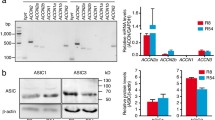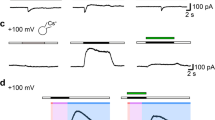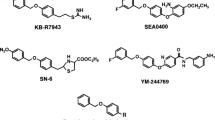Abstract
Studies were conducted using a novel in vitro approach to investigate the efficacy of acetamidine hydrochloride (ACE) and guanidine hydrochloride (GUAN), previously shown to block gramicidin D (GRAM) channels in artificial membranes, in preventing the toxic effects of GRAM in NG108-15 (neuroblastoma×glioma hybrid) cells. Specifically, intracellular microelectrode techniques were employed to examine changes in membrane resting potential (V m) and input resistance (R in). At 1 μmol/L, ACE significantly reduced loss of V m induced by 1 or 10 μg/ml GRAM, although higher concentrations of ACE did not afford enhanced antagonism. GUAN, in contrast, produced a concentration-dependent antagonism of GRAM-induced V m and R in loss, with high concentrations (10 or 100 μmol/L) completely preventing diminutions in both V m and R in. In control cells superfused without GRAM, ACE produced a direct, concentration-dependent reduction in V m and R in, whereas GUAN hyperpolarized NG108-15 cells but did not alter R in. These data represent the initial demonstration of the reversal of GRAM toxicity in an intact cell system.
Similar content being viewed by others
References
Balestrino M. Pathophysiology of anoxic depolarization: new findings and a working hypothesis. J Neurosci Methods. 1995;59:99–103.
Bamberg E, Lauger P. Blocking of the gramicidin channel by divalent cations. J Membr Biol. 1977;35:351–75.
Benoit E. Interactions of guanidine and a related compound with potassium channels in frog myelinated nerve fiber. Receptors Channels. 1993;1:181–91.
Braun AP, Schulman H. A non-selective cation current activated via the multifunctional Ca2+-calmodulin-dependent protein kinase in human epithelial cells. J Physiol. 1995;488:37–55.
Brown DA, Higashida H. Voltage-and calcium-activated potassium currents in mouse neuroblastoma × rat glioma hybrid cells. J Physiol (Lond). 1988;397:149–65.
Cereda E, Ezhaya A, Quintero MG et al. Synthesis and biological evaluation of new antimuscarinic compounds with amidine basic centers. A useful bioisosteric replacement of classical cationic heads. J Med Chem. 1990;33:2108–13.
Doebler JA. Membrane potential and resistance changes in NG108–15 cells: an in vitro model to study membrane-active compounds. Toxicol Methods. 1999;9:1–11.
Duchen MR. Effects of metabolic inhibition on the membrane properties of isolated mouse primary sensory neurons. J Physiol (Lond). 1990;424:387–409.
Elmqvist D, Lambert EH. Detailed analysis of neuromuscular transmission in a patient with the myasthenic syndrome sometimes associated with bronchogenic carcinoma. Mayo Clin Proc. 1968;43:689–713.
Farkas DL, Wei M, Febbroriello P, Carson JH, Loew LM. Simultaneous imaging of cell and mitochondrial membrane potentials. Biophys J. 1989;56:1053–69.
Hemsley G, Busath D. Small iminium ions block gramicidin channels in lipid bilayers. Biophys J. 1991;59:901–8.
Higashida H, Streaty RA, Klee W, Nirenberg M. Bradykinin-activated transmembrane signals are coupled via No or Ni to production of inositol 1,4,5-triphosphate, a second messenger in NG108–15 neuroblastoma-glioma hybrid cells. Proc Natl Acad Sci USA. 1986;83:942–6.
Hirsch JA. Structure-activity relationship between guanidine alkyl derivatives and norepinephrine release: site(s) and mechanism(s) of action. J Pharmacol Exp Ther. 1984;230:710–7.
Lenga RE (ed). Sigma Aldrich Library of Chemical Safety Data. Ed II. Vol I. St Louis, MO: Sigma Aldrich Corp.; 1988.
Leung J, Eisenberg RS. The effects of the antibiotics gramicidin A, amphotericin B, and nystatin on the electrical properties of frog skeletal muscle. Biochim Biophys Acta. 1973;298:718–23.
Lichtshtein D, Dunlop K, Kaback HR, Blume AJ. Mechanism of monensin-induced hyperpolarization of neuroblastoma-glioma hybrid NG108–15. Proc Natl Acad Sci USA. 1979;76:2580–4.
Loew LM, Benson L, Lazarovici P, Rosenberg I. Fluorometric analysis of transferable membrane pores. Biochemistry. 1985;24:2101–4.
Lundh L, Thesleff S. The mode of action of 4-aminopyridine and guanidine on transmitter release from motor nerve terminals. Eur J Pharmacol. 1977;42:411–2.
Lundh L, Leander S, Thesleff S. Antagonism of the paralysis produced by botulinum toxin in the rat. The effects of tetraethylammonium, guanidine and 4-aminopyridine. J Neurol Sci. 1977;32:29–43.
McBride D, Szabo G. Blocking of gramicidin channel conductance by Ag+. Biophys J. 1978;21:25a.
Molgo J, Mallart A. The mode of action of guanidine on mouse motor nerve terminals. Neurosci Lett. 1988;89:161–4.
Myers VB, Haydon DA. Ion transfer across lipid membranes in the presence of gramicidin A. II. The ion selectivity. Biochim Biophys Acta. 1972;274:313–22.
Neher E. Ion specificity of the gramicidin channel and the thallous ion. Biochim Biophys Acta. 1975;401:540–4.
Ohtsuyama M, Suzuki Y, Samman G, Sato F, Sato K. Cell volume analysis of gramicidin-treated eccrine clear cells to study regulation of Cl channels. Am J Physiol. 1993;265:C1090–9.
Podleski T, Changeux J-P. Effects associated with permeability changes caused by gramicidin A in electroplax membrane. Nature. 1969;221:541–5.
Rao KK. Central anti-serotonin activity of two newer acetamidine compounds, B.W. 501 C 67 and B.W. 204 C 67. Jpn J Pharmacol. 1971;21:485–7.
Shvinka NE, Toropova FV. Effect of gramicidin A and thallium ions on cation effluxes in frog sartorius muscle. Gen Physiol Biophys. 1985;4:493–500.
Sorrentino R, Sautebin L, Pinto A. Effect of methylguanidine, guanidine and structurally related compounds on constitutive and inducible nitric oxide synthase activity. Life Sci. 1997;61:1283–91.
Urry DW, Goodall MC, Glickson JD, Mayers DF. The gramicidin A transmembrane channel: characteristics of head-to-head dimerized π(L,D) helices. Proc Natl Acad Sci USA. 1971;68:1907–11.
Vedasiromoni JR, Ganguly DK. N-Carbamoyl-2-(2,6-dichlorophenyl)acetamidine hydrochloride (LON-954), a tremorogen, on rat diaphragm. Jpn J Pharmacol. 1984;34:353–5.
Volle RL, Branisteanu DD. Statistical parameters of transmitter release at frog neuromuscular junctions treated with guanidine or tetraethylammonium. J Pharmacol Exp Ther. 1976;197:653–61.
Woolley GA, Wallace BA. Model ion channels: gramicidin and alamethacin. J Membr Biol. 1992;129:109–36.
Author information
Authors and Affiliations
Rights and permissions
About this article
Cite this article
Doebler, J. Gramicidin toxicity in NG108-15 cells: protective effects of acetamidine and guanidine. Cell Biol Toxicol 15, 279–289 (1999). https://doi.org/10.1023/A:1007651417519
Issue Date:
DOI: https://doi.org/10.1023/A:1007651417519




